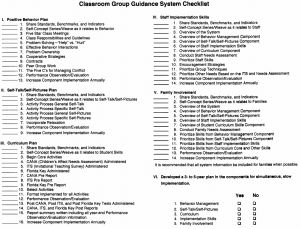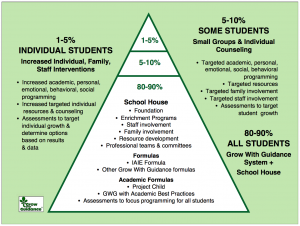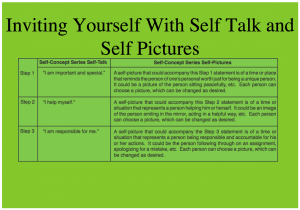Building Strong Self-Worth in All Elementary School Students Using Multitiered Systems of Support
Building a strong and core sense of self from a young age is critical to success in school and in life and is one of the basic building blocks of being successful in the social, emotional, academic and career realms. With interventions to build a strong sense of self, it is crucial that we target each level in a MTSS so that students graduate from elementary school knowing that they hold integral value and worth, regardless of whether they are excelling in school. In fact, developing a strong and intrinsic sense of self that is not tied to external markers of success and accomplishment is key to thriving.
Building Strong Self-Worth in All Elementary School Students Using Multitiered Systems of Support
AOCC Conference, October 18, 2023
Christine Suniti Bhat, PhD, LSC, LPC ([email protected])
Tommie Radd, PhD, LPC ([email protected])
Kristin Chamberlain, PhD, LSC, LPC ([email protected])
The Tommie Radd Professorship in School Counselor Education Ohio University Counselor Education
Objectives
Objective 1
• Participants will receive an overview of research regarding the importance of building a secure sense of self-worth in elementary school students.
Objective 2
• Participants will learn the Self-Talk/Self-Picture System Component (Radd, 2021) from The Grow with Guidance Systems Model (2021) that aligns with the ASCA National Model (2019) as a comprehensive, developmental, and results-oriented framework for prevention and intervention in schools.
Objective 3
• Participants will obtain interventions to build a strong sense of self-worth suitable for implementation at each tier in a Multitiered System of Supports (MTSS; ASCA, adopted 2008, revised 2014, 2018, 2021).
Objective 4
• Participants will actively engage in discussion on how to adapt interventions to build a secure self of self in students at Tiers 1, 2, and 3 so that results will permeate through the whole school community. Participants will receive information on how to measure the effectiveness of strategies, including how they might partner with Ohio University to implement the Grow with Guidance system and complete pre-and-post assessments.
Self
• SELF-WORTH – a sense of one’s own innate value as a human being. Self-worth is the internal sense of being good enough and worthy of love and belonging from others.
• SELF-WORTH THEORY – An individual’s main priority in life is to find self- acceptance (Covington & Beery, 1976).
• SELF-CONCEPT – Self-concept is the image we have of ourselves, both positive and negative attributes.
• UNCONDITIONAL SELF ACCEPTANCE (USA) proposed by Albert Ellis.
• A POSTIVE SELF-CONCEPT IS REFLECTED IN A HIGH SENSE OF SELF- WORTH.
• HEALTHY SELF-CONCEPT DEVELOPMENT is essential for student success (Radd, 2021).
Importance of Secure Sense of Self-Worth Self-Concept during Elementary School
• Improved social cognition
• Students with a secure self-concept are better at recognizing emotions (positive and neutral facial expressions) in others (Cordeiro et al., 2021).
• Students feel more confident about class participation (Lobos et al, 2019).
• Higher attendance rates (Lobos et al., 2019).
• Students experience a decrease in self-worth when transitioning to middle school (Onetti et al., 2019).
The Grow with Guidance (GWG) Systems Model (Radd, 2021)
• The GWG system is a developmental, performance-based system for use in schools
• The GWG system includes six interactive components:
• Self-Talk, Self Pictures; Behavior Management; Implementation; Curriculum; Family Involvement; Observation/Evaluation
• The Self-Concept series and weave is present in each component to guide students to develop a strong secure self-concept.
• All activities engage the students in the process.
• Each activity builds on the previous activities, so it is a learning process that requires reviewing, connection, and practice.
The Core of the Grow with Guidance System
• The Self-Concept series is one of the core concepts of the GWG System
• Truth & Unconditional Acceptance: All people are special and valuable because they are unique and different from one another.
• Behavior: This uniqueness comes with an inherent responsibility to help and not hurt self or others.
• Accountability: People are responsible for self monitoring which translates to them embracing their uniqueness and worth (Radd, 2021).
The Self-Concept Series in the GWG Model is Taught to All Students
• All are important and valuable no matter what they think, say, feel, and do.
• All show they are remembering their worth by making helpful choices toward themselves and others. They are
responsible for helping, not hurting self and others.
• All are responsible for their choices. This accountability empowers all to make improvements because of their worth.
NOTE: Listen to podcast at https://allsucceed.com/media/
Multitiered System of Supports (MTSS)
• School counselors align their work with MTSS by utilizing a school counseling program to promote positive changes in students’ academics, career exploration, and behavior.
• Tier 1: Classroom instruction and schoolwide programming.
• Tier 2: Small group and individual sessions, collaboration with school personnel, parents, and community members.
• Tier 3: Indirect student support services through consultation and collaboration (ASCA 2021).
MTSS Level 1 Interventions to Address Self Worth and Self Concept from the GWG System Model
• Self-Talk/Self-Picture System Component (Radd, 2021)
• Students replace negative self-talk with positive self-talk through activities with their peers.
• Students touch the tops of their heads when the hurtful thoughts are occurring, and then toss the thoughts out. They take their other hand and place thoughtful thoughts into their head.
• They also practice positive self-talk statements with partners.
Self-Concept Series: Self-Talk and Self-Pictures
MTSS Level 1 Interventions to Address Self Worth and Self Concept from the GWG System Model
• Students replace negative self-pictures with positive ones through activities.
• Students are asked to draw the negative pictures, then crumple them and throw them away. Then, they draw
positive pictures to replace those negative ones.
• Students keep these positive pictures at their desk to help them remember that they are unique and valued.
MTSS Level 1 and Level 2 Interventions to Address Self Worth and Self Concept from the GWG System Model
• My Personal Self Talk Self Picture Plan can be used with individuals or in small group counseling.
• The counselor leads individuals or small groups of students through exploring
• General Self-Talk
• Specific Self-Talk
• Self-Picture Description
• Remember to Use Self-Talk-Self-Pictures when
• Remember to Relax when
• Observe and Adjust
Available from https://allsucceed.com/wp-content/uploads/2017/10/Page- 72-of-INTERMEDIATE.pdf
MTSS Level 1 and Level 2 Interventions to Address Self Worth and Self Concept from the GWG System Model
• Inside-Outside Self (page 186-188, GWG System, Primary Level)
• Students lie on the floor and have a classmate trace their outline.
• On the Outside Self, they draw, paint, or color themselves.
• On the Inside Self on the reverse of the sheet they draw pictures to represent their feelings or thoughts.
• Inside-Outside Self drawings are then shared with classmates in small groups.
MTSS Level 3 Interventions to Address Self Worth and Self Concept from the GWG System Model
• Student will define and describe feelings related to a personal experience.
• The counselor engages the student to discuss feelings they experience at different times.
• Student will recognize feelings they have had on a difficult day.
• The counselor will help the student recognize feelings they have had on a difficult day and help the student normalize the experience of having a challenging day.
• Student will identify and express characteristics that are special and unique about themselves.
• The counselor leads the student through this activity to disrupt negative self talk/negative self image.
Small Groups Discussion: What interventions do you use to increase self worth in your students?
Partnering with the Dr. Tommie Radd Professorship in School Counselor Education
• School counselors interested in partnering with the Dr. Tommie Radd professorship in School Counselor Education should contact:
• Dr. Christine Suniti Bhat ([email protected])
• Dr. Kristin Chamberlain ([email protected])
• GWG System Model materials provided at cost
• Aligned with the ASCA National Model
• Pre-post Assessment Instrument – the Childrens Affect and Needs Scale (CANA)
• CANA is available in paper and pencil format or on Qualtrics
• Free data analysis through the Dr. Tommie Radd Professorship in School Counselor Education
References
American School Counselor Association [ASCA]. (2019). The ASCA National Model: A Framework for School Counseling Programs, 4th ed. Alexandria VA: Author.
American School Counselor Association [ASCA]. (2008, 2014, 2018, 2021). The School Counselor and Multitiered System of Supports. Retrieved from https://www.schoolcounselor.org/Standards-Positions/Position-Statements/ASCA-Position-Statements/The-School-Counselor-and-Multitiered-System-of-Sup
Cordeiro, T., Botelho, J., & Mendonça, C. (2021). Relationship Between the Self-Concept of Children and Their Ability to Recognize Emotions in Others. Frontiers in Psychology, 12. https://doi-org.proxy.library.ohio.edu/10.3389/fpsyg.2021.672919
Goodman-Scott, E., Betters-Bubon, J., Olsen, J., & Donohue, P. (2020). Making MTSS Work. American School Counselor Association.
Radd, T. R. (2021). Teaching and Counseling for Today’s World: Pre-K-12 and Beyond, 2nd ed. Gahanna OH: Grow with
Guidance.
Radd, T. R. (2007). The grow with guidance system: Primary level. Gahanna OH: Grow with Guidance.
Radd, T. R. (2007). The grow with guidance system manual. Gahanna OH: Grow with Guidance.
Lobos, K., Bustos, C., & Díaz, A. (2019). Impact of teacher training on academic self-concept
and educational outcomes. Electronic Journal of Research in Educational Psychology, 17(49), 519-540–540.
https://doi-org.proxy.library.ohio.edu/10.25115/ejrep.v17i49.2219
Onetti, W., Fernández-García, J. C., & Castillo-Rodríguez, A. (2019). Transition to middle school: Self-concept
changes. PLoS ONE, 14(2), 1–12. https://doi-org.proxy.library.ohio.edu/10.1371/journal.pone.0212640
Ziomek-Daigle, J., Goodman-Scott, E., Cavin, J., & Donohue, P. (2016). Integrating a multi-tiered system of
supports with comprehensive school counseling program. Retrieved from: h
http://tpcjournal.nbcc.org/integrating-a-multi-tiered-system-of-supports-with- comprehensive-
school-counseling-programs/

Want to stay up to date with the latest news, events, and presentations?
Receive all this and more straight to your email!




